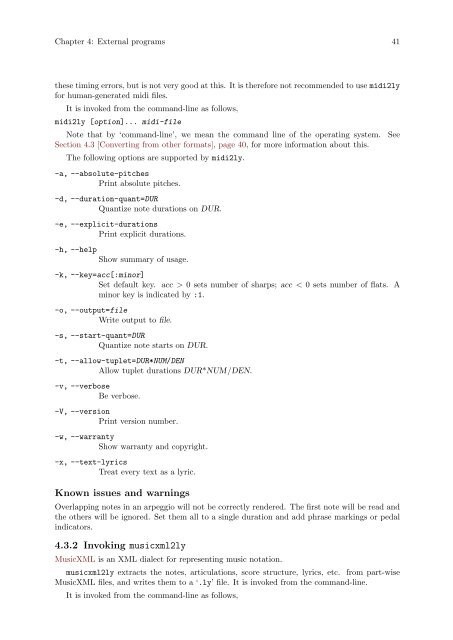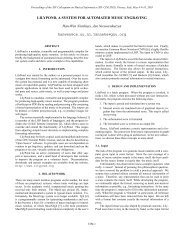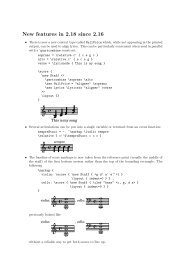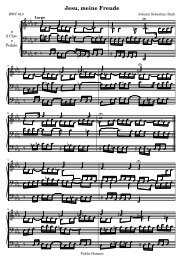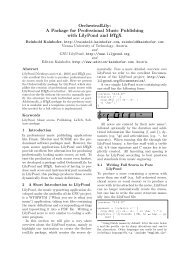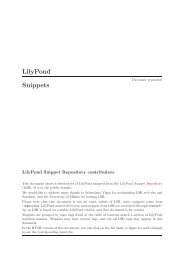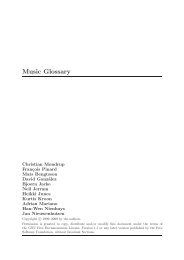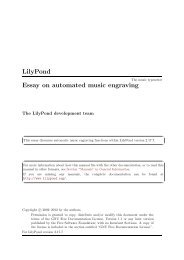Section âTroubleshootingâ in Application Usage - LilyPond
Section âTroubleshootingâ in Application Usage - LilyPond
Section âTroubleshootingâ in Application Usage - LilyPond
You also want an ePaper? Increase the reach of your titles
YUMPU automatically turns print PDFs into web optimized ePapers that Google loves.
Chapter 4: External programs 41<br />
these tim<strong>in</strong>g errors, but is not very good at this. It is therefore not recommended to use midi2ly<br />
for human-generated midi files.<br />
It is <strong>in</strong>voked from the command-l<strong>in</strong>e as follows,<br />
midi2ly [option]... midi-file<br />
Note that by ‘command-l<strong>in</strong>e’, we mean the command l<strong>in</strong>e of the operat<strong>in</strong>g system.<br />
<strong>Section</strong> 4.3 [Convert<strong>in</strong>g from other formats], page 40, for more <strong>in</strong>formation about this.<br />
The follow<strong>in</strong>g options are supported by midi2ly.<br />
-a, --absolute-pitches<br />
Pr<strong>in</strong>t absolute pitches.<br />
-d, --duration-quant=DUR<br />
Quantize note durations on DUR.<br />
-e, --explicit-durations<br />
Pr<strong>in</strong>t explicit durations.<br />
-h, --help<br />
Show summary of usage.<br />
-k, --key=acc[:m<strong>in</strong>or]<br />
Set default key. acc > 0 sets number of sharps; acc < 0 sets number of flats. A<br />
m<strong>in</strong>or key is <strong>in</strong>dicated by :1.<br />
-o, --output=file<br />
Write output to file.<br />
-s, --start-quant=DUR<br />
Quantize note starts on DUR.<br />
-t, --allow-tuplet=DUR*NUM/DEN<br />
Allow tuplet durations DUR*NUM/DEN.<br />
-v, --verbose<br />
Be verbose.<br />
-V, --version<br />
Pr<strong>in</strong>t version number.<br />
-w, --warranty<br />
Show warranty and copyright.<br />
-x, --text-lyrics<br />
Treat every text as a lyric.<br />
Known issues and warn<strong>in</strong>gs<br />
Overlapp<strong>in</strong>g notes <strong>in</strong> an arpeggio will not be correctly rendered. The first note will be read and<br />
the others will be ignored. Set them all to a s<strong>in</strong>gle duration and add phrase mark<strong>in</strong>gs or pedal<br />
<strong>in</strong>dicators.<br />
4.3.2 Invok<strong>in</strong>g musicxml2ly<br />
MusicXML is an XML dialect for represent<strong>in</strong>g music notation.<br />
musicxml2ly extracts the notes, articulations, score structure, lyrics, etc. from part-wise<br />
MusicXML files, and writes them to a ‘.ly’ file. It is <strong>in</strong>voked from the command-l<strong>in</strong>e.<br />
It is <strong>in</strong>voked from the command-l<strong>in</strong>e as follows,<br />
See


